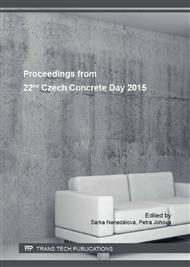p.85
p.91
p.96
p.102
p.108
p.112
p.119
p.125
p.131
Flexural Strength of the Reactive Powder Concrete
Abstract:
Reactive powder concrete (RPC) is cement composite which is characterized by an absence of coarse aggregate. That resulted in a greater homogeneity of the mixture and thus also in a higher compressive strength. On the other side, the absence of coarse aggregate and typically a large volume of the paste lead to the deterioration of some of the properties of concrete. This paper deals with the relationship between maximum aggregate size and flexural strength of the reactive powder concrete without dispersed reinforcement. Quartz sand with maximum grain size of 1, 2 and 4 mm was used for the experiments. The flexural strength was measured through the four-point bending test on prisms 100 x 100 x 400 mm. Further, the quartz powder and ground granulated blast furnace slag were used as addition and compared with each other. The results of the experiments showed that the flexural strength grows with decreasing aggregate size. This tendency was observed in mixtures with quartz powder and also with ground granulated blast furnace slag. On the contrary, the compressive strength was independent on aggregate size, but dependent on the type of used addition.
Info:
Periodical:
Pages:
108-111
Citation:
Online since:
April 2016
Authors:
Price:
Сopyright:
© 2016 Trans Tech Publications Ltd. All Rights Reserved
Share:
Citation:


